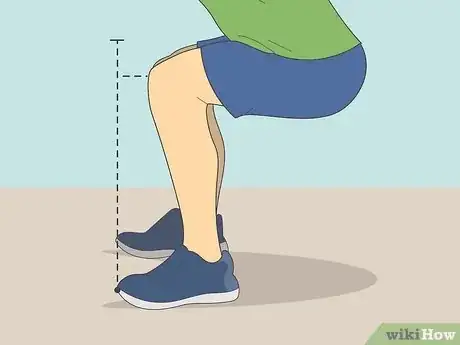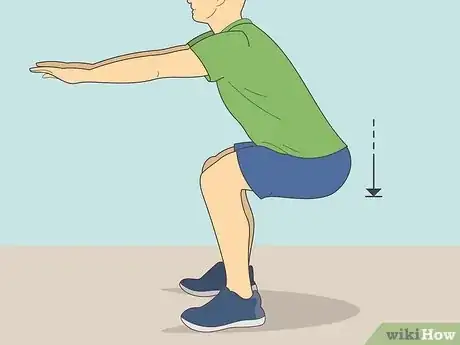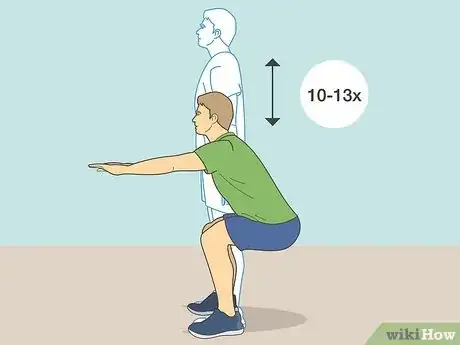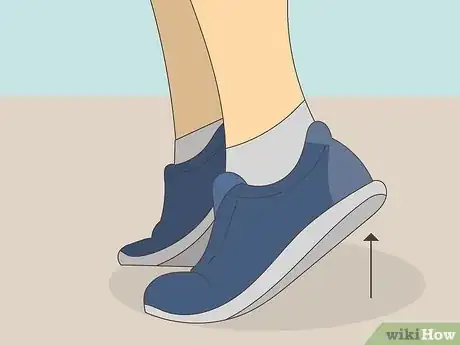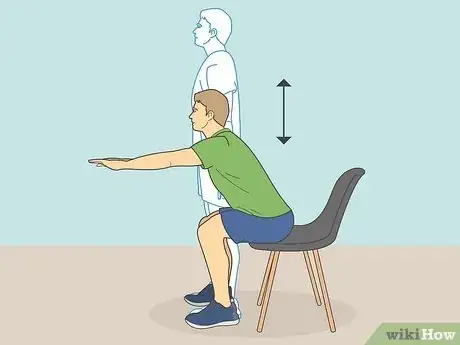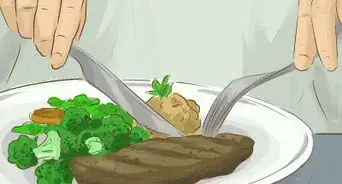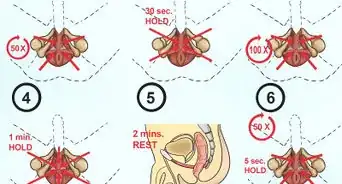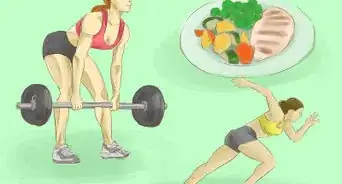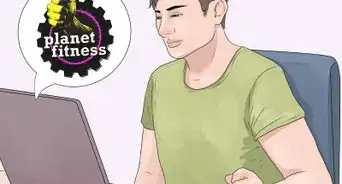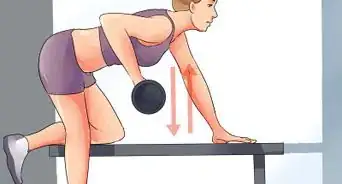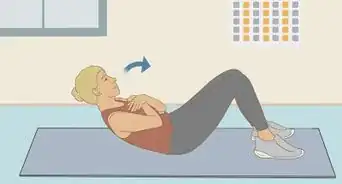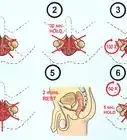This article was co-authored by Dean Theriot. Dean Theriot is a Personal Trainer and the Owner of Timberline Fitness in Houston, Texas. With over 25 years of experience in the fitness industry, Dean specializes in personal, group, and sport-specific training. Dean holds a BS in Exercise Physiology from LSU. Dean combines resistance and cardiovascular training with pilates exercises for comprehensive workouts for his clients. His sport-specific training includes football, basketball, and baseball.
This article has been viewed 95,518 times.
The squat is considered by many to be the most important exercise. Although many people favor either the bench press or hip and abdominal exercises, the free squat—a squat that is done without any equipment or machines—is a simple yet extremely effective exercise. Free squats—also called bodyweight squats—work to strengthen the legs and hip muscles, increase balance, increase range of motion, and stretch your muscles (in the bottom position). Free squats can give your legs great endurance and noticeable tone.
Steps
Protecting Your Knees
-
1
-
2Keep your knees behind your toes. This protects your knees and back and helps you achieve maximum results. When you move into a squat, bend your knees so that they move directly over your feet, without going further than your toes.[3] [4]Advertisement
-
3Keep your feet shoulder-width apart. For a standard free squat, start by keeping your feet under your shoulders. This help to avoid stress on your knees.[5]
-
4Angle your feet for plié squats. A plié squat is a free squat done with a wide stance. For these, it is important to angle your feet out and to bend your knees so they move directly over your feet. Begin by doing these at only a half-range of motion, and work up to getting your knee bends to 90 degrees.[6]
-
5Stop at the bottom. After you build up some leg strength, you may begin to "break 90," or allow your squat to deepen more than a 90-degree bend in your knees. However, it is important to stop when your thighs lightly come into contact with your calves. Going beyond this can place unnecessary stress on your knees.[7]
Protecting Your Back
-
1Keep your core tight and chest upright. If not done carefully, squatting can put a lot of strain on your lower back. Protect your back and ensure proper form by keeping your core muscles firmly engaged. Imagine you are contracting your belly button toward the middle of your back. As you keep your tummy tight, this should help you to hold your chest upright. Imagine that you are trying to let sun shine on the top of your clavicle and chest.[8]
-
2Avoid bouncing. Descend with control and ascend in any manner, however do not ascend without braking at the top. When you see professional or elite athletes doing squatting movements very fast, they are moving with control.
-
3Increase your reps over time. Build your squatting ability over several workouts by adding a repetition or two every workout. Squat as often as twice a week. Begin by doing just one set of 10-13 reps (or repetitions). Add a couple of reps, or a set, each time you work out. Build up strength and increase your reps slowly in order to protect your spine and avoid injury.[9]
Trying Different Varieties
-
1Do free squats on the balls of your feet. If you come up to the balls of your feet while squatting (also called relevé) you will work your calf muscles. You try staying up on your toes the whole time, or simply doing a calf-raise at the top of each squat.[10]
-
2Try chair squats. Instead of moving up and down in your free squats, try sitting back and doing an isometric hold. That is, hold yourself in the bottom squat position as if you are sitting in a chair. Try holding this for 30 seconds, and adding time as you get stronger. You can also try doing this against a wall.[11]
-
3Mix up your workouts. Doing a variety of squats works more muscles and makes your workout varied and more fun. Additionally, when the leg muscles are strengthened, a person's metabolism becomes more active. Performing a mix of different squat exercises works more muscles and revs up your metabolism to burn more calories.[12]
Expert Q&A
-
QuestionHow many squats do I need to do a day?
 Michele DolanMichele Dolan is a BCRPA certified Personal Trainer in British Columbia. She has been a personal trainer and fitness instructor since 2002.
Michele DolanMichele Dolan is a BCRPA certified Personal Trainer in British Columbia. She has been a personal trainer and fitness instructor since 2002.
Certified Fitness Trainer If you are practicing body weight squats and your joints are all healthy, consider how many times a day you get up out of a chair: 20? 30? 50? Use that as your starting point. If you are using additional weight, aim for 2-3 workouts per week with 30-60 squats per workout.
If you are practicing body weight squats and your joints are all healthy, consider how many times a day you get up out of a chair: 20? 30? 50? Use that as your starting point. If you are using additional weight, aim for 2-3 workouts per week with 30-60 squats per workout. -
QuestionWhat do squats do for a woman's body?
 Michele DolanMichele Dolan is a BCRPA certified Personal Trainer in British Columbia. She has been a personal trainer and fitness instructor since 2002.
Michele DolanMichele Dolan is a BCRPA certified Personal Trainer in British Columbia. She has been a personal trainer and fitness instructor since 2002.
Certified Fitness Trainer Squats build the muscles of the thighs and buttocks, so they can be a good exercise for women who want to tone these areas.
Squats build the muscles of the thighs and buttocks, so they can be a good exercise for women who want to tone these areas. -
QuestionHow do I do squats without weights?
 Michele DolanMichele Dolan is a BCRPA certified Personal Trainer in British Columbia. She has been a personal trainer and fitness instructor since 2002.
Michele DolanMichele Dolan is a BCRPA certified Personal Trainer in British Columbia. She has been a personal trainer and fitness instructor since 2002.
Certified Fitness Trainer You can practice squats with your arms crossed in front of your chest or stretched forward.
You can practice squats with your arms crossed in front of your chest or stretched forward.
References
- ↑ Dean Theriot. Personal Trainer. Expert Interview. 22 February 2021.
- ↑ https://www.nerdfitness.com/blog/strength-training-101-how-to-squat-properly/
- ↑ Dean Theriot. Personal Trainer. Expert Interview. 22 February 2021.
- ↑ https://www.nerdfitness.com/blog/strength-training-101-how-to-squat-properly/
- ↑ https://www.nerdfitness.com/blog/strength-training-101-how-to-squat-properly/
- ↑ http://www.shape.com/fitness/workouts/12-ways-spice-your-squats-better-results
- ↑ http://www.shape.com/fitness/workouts/12-ways-spice-your-squats-better-results
- ↑ https://stronglifts.com/squat/
- ↑ http://www.shape.com/fitness/workouts/12-ways-spice-your-squats-better-results


